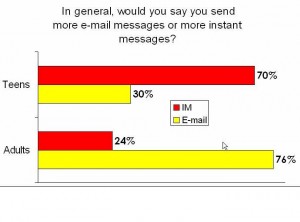From Innovations, a website published by Ziff-Davis Enterprise from mid-2006 to mid-2009. Reprinted by permission.
The concept of “presence” is altering business communications. Will you be ready to speak to the next generation of professionals on their own terms?
The chart below should tell you a lot about the future of the workplace. For the past three years, the Associated Press and America Online have measured the use of e-mail and instant messaging (IM) by teens and adults. In all three surveys, the results have been similar: usage patterns are nearly reversed between the two groups, with teens overwhelmingly preferring IM.
 |
|
Source: Associated Press/America Onlin, Nov., 2007 |
Why? In part, teens admit, it’s to avoid confrontation and embarrassment by taking the face-to-face element out of awkward situations. But equally important is that IM reflects teenagers’ always-connected lifestyles. IM is instantaneous, requires little forethought and lends itself well to use with cell phones, the ubiquitous teen accessory.
Today’s young people expect that their friends will always be available to them, regardless of where they are. Teens are no less communicative than their parents; 50% of them use IM more than one hour a day, compared to 24% of adults, according to the poll. It’s that the nature of their communications is different. They don’t have time to get to a computer or to carefully compose their thoughts before stating them. When they have something to say, they want to just say it.
Experts call this “presence:” our availability and our preferred communications media are a matter of record to the people who need to reach us, whether they’re family, colleagues or customers. Presence reflects the fact that people are no longer anchored to their desks. They work at home or on the road most of the time. Location is a critical element of presence. Increasingly, our online profiles will include up-to-date information on where we are and how available we want to be. Sophisticated cell phone tracking technology and global positioning systems may even make this transparent to us.
Presence will redefine workplace communications. The New York Times recently reported on the evolution of social networking to include cell phones, which are the primary Internet access points for most of the developed world. Many of these services factor location into member profiles. At work, we will need to broadcast our location constantly, since the hyperactive business world no longer tolerates delay. Corporate directories are evolving to include rich information about people’s background and expertise, along with the means to tap into their knowledge whenever someone in the organization needs it.
The trick will be to balance our need for concentration with the requirement of availability. I imagine many people blanch at the idea that they would be expected to turn on a dime anytime someone else in their organization needed a question answered. That’s a problem that will be addressed through standards of conduct that will emerge as the technology takes hold. However, the new rules are becoming clear. The next generation of business professionals won’t tolerate the delays that are inherent in business communications. They are always online, and they expect their colleagues to be there as well.
